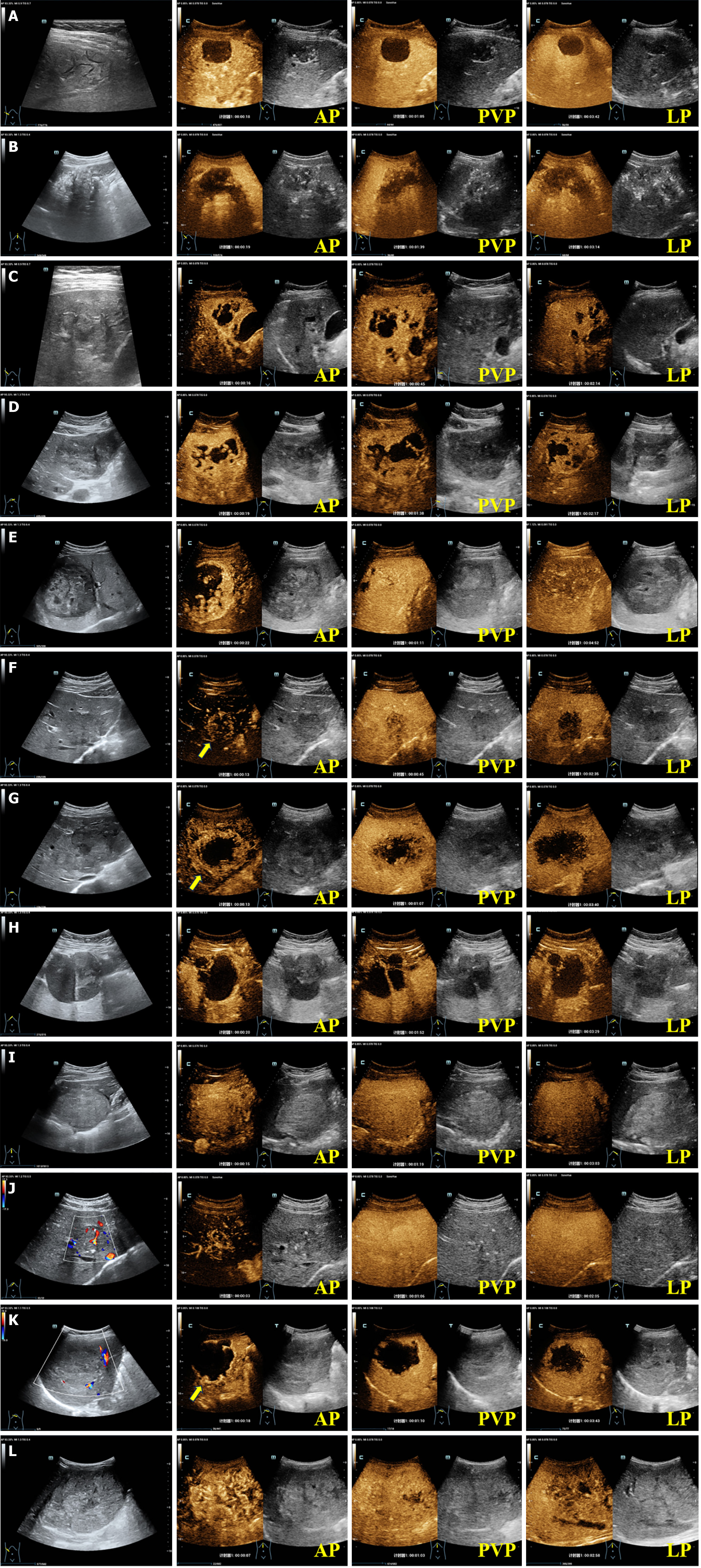Copyright
©The Author(s) 2024.
World J Gastroenterol. Oct 7, 2024; 30(37): 4115-4131
Published online Oct 7, 2024. doi: 10.3748/wjg.v30.i37.4115
Published online Oct 7, 2024. doi: 10.3748/wjg.v30.i37.4115
Figure 5 Contrast-enhanced ultrasound images of solid focal liver lesions.
A: A 37-year-old female patient presenting with a lesion of hepatic cystic echinococcosis 4, revealing no enhancement in the arterial phase (AP), portal venous phase (PVP), and late phase (LP); B: A 30-year-old female patient presenting with a hailstorm hepatic alveolar echinococcosis lesion, exhibiting irregular mild hyper-enhancement around the periphery in the AP and hypo-enhancement in the PVP and LP, resembling a “worm-eaten” appearance, with no significant enhancement observed in most of the internal regions; C: A 49-year-old female patient presenting with a lesion consistent with paragonimiasis, exhibiting heterogeneous enhancement in the AP, with non-enhancing reticular and “tunnel-like” areas internally; D: A 70-year-old female patient presenting with a liver abscess, showing hyper-enhancement of the cystic wall and internal septa in the AP, with multiple patches of non-enhancing liquefied necrotic areas, creating a “honeycomb-like” pattern; E: A 73-year-old male patient presenting with a lesion from hepatocellular carcinoma, exhibiting heterogeneous hyper-enhancement in the AP, iso-enhancement in the PVP, and hypo-enhancement in the LP; F: A 36-year-old male patient presenting with a lesion indicative of intrahepatic cholangiocarcinoma, showing irregular “rim-like” peripheral enhancement in the AP (the yellow arrow), washout in the PVP, and significant hypo-enhancement in the LP; G: A 40-year-old male patient presenting with liver metastasis, showing thick “rim-like” hyper-enhancement in the early AP (the yellow arrow), with washout in the early PVP and marked hypo-enhancement in the LP, presenting as a “bull's eye” sign; H: A 57-year-old female patient presenting with hepatic biliary cystadenoma. The lesion shows slight enhancement of the wall and septa in the AP, with some areas exhibiting thickened septa and dense nodular enhancement, followed by decreased enhancement in the PVP and LP; I: A 14-year-old female patient presenting with hepatocellular adenoma. The lesion shows slight hyper-enhancement in the AP and LP, and iso-enhancement in the LP; J: A 23-year-old male patient presenting with a lesion consistent with focal nodular hyperplasia, characterized by centrifugal enhancement in a “spoke-wheel” or “firework-like” pattern extending from the center to the periphery in the AP. The lesion shows slight hyper-enhancement in the PVP, and iso-enhancement in the LP; K: A 57-year-old female patient presenting with hepatic sclerosing hemangioma. The lesion shows discontinuous, nodular peripheral enhancement in the AP (the yellow arrow), with progressive partial or complete centripetal fill-in in the PVP and slight hyper-enhancement in the LP, as well as patchy non-enhancing areas observed internally; L: A 2-year-old male patient presenting with a lesion associated with hepatoblastoma, showing hyper-enhancement in the AP, slight hypo-enhancement in the PVP, and hypo-enhancement in the LP.
- Citation: Tao Y, Wang YF, Wang J, Long S, Seyler BC, Zhong XF, Lu Q. Pictorial review of hepatic echinococcosis: Ultrasound imaging and differential diagnosis. World J Gastroenterol 2024; 30(37): 4115-4131
- URL: https://www.wjgnet.com/1007-9327/full/v30/i37/4115.htm
- DOI: https://dx.doi.org/10.3748/wjg.v30.i37.4115









